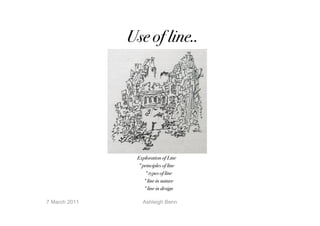
Exploring lines
- 1. Use of line.. Exploration of Line * principles of line * types of line * line in nature * line in design 7 March 2011 Ashleigh Benn
- 2. Principles of line Qualities of line • Depth, Tone (thickness) • Gradient • Direction (movement) • Organic • Geometric • Curvilinear • Rectilinear 7 March 2011 Ashleigh Benn
- 3. Types of line http://cnx.org/content/m24870/latest/ 7 March 2011 Ashleigh Benn
- 4. Depth, Tone and Thickness • As one can see in the picture here, alternative pressures and thickness' used in line can create depth and tone. The closer the line the deeper the image. 7 March 2011 Ashleigh Benn
- 5. Gradient • The intense usage of line here creates an intensity in the mark making, one can almost feel the depth that has been created. 7 March 2011 Ashleigh Benn
- 6. Direction, Movement • In this image, fast paced movements are shown in the lines that are very close together and dark in colour. The less ‘angry’ lines depict the ‘froth’ of the wave, which is lighter and http://artandwater.blogspot.com/2010_04_01_archive.html more gentle. 7 March 2011 Ashleigh Benn
- 7. Continuous • Continuity in line can give a soft feminine emotion, and can also give depth without having to place intensive tonal elements. http://johngushue.typepad.com/blog/2008/01/continuity.html 7 March 2011 Ashleigh Benn
- 8. Organic • Organic lines are found in nature and form irregular shapes. In this image the loosely drawn lines give a smooth texture to the drawing as well as a relaxed emotional quality. http://perfect-imperfection.com/2009/06/organic/ 7 March 2011 Ashleigh Benn
- 9. Geometric • This picture shows thought and measurements. There are calculations in the line and this depicts an almost clinical approach in the mark making. http://www.abcteach.com/directory/clip_art/art_and_artists/ 7 March 2011 Ashleigh Benn
- 10. Curvilinear • This image is characterized by curved lines. Here the piece takes on a feminine, mystical feeling because of the ‘fairytale’ quality of the line. 7 March 2011 Ashleigh Benn
- 11. Rectilinear • A masculine form of line that is characterized by straight lines. Here the straight lines are used to give an accurate perspective. 7 March 2011 Ashleigh Benn
- 12. Drawn line • Hand drawn lines add an emotional emphasis to an image that is rarely seen in any other form of mark making, the creator of the images shows part of their own emotional path on the paper. 7 March 2011 Ashleigh Benn
- 13. Horizontal • This is one of artist Dana McClure’s line series, I thought this piece was breathtaking and loved the way she enforced texture by using changes in tone and colour in her line work. Horizontal lines evoke a restful feeling, the line also has a masculine quality. http://www.lostateminor.com/2010/12/18/dana-mcclures-line- 7 March 2011 Ashleigh Bennseries/
- 14. Vertical • I thought this was an interesting example of vertical line usage. If you look closely at the eye, one can see all the actual marks that have been made are vertical. This gives the piece a ‘somber’ emotion and a slightly more masculine quality. http://feathertickler.deviantart.com/art/Vertical-Line-Drawing- 140491768 7 March 2011 Ashleigh Benn
- 15. Contour • Contour lines give shape and movement with little tonal value. There is something rather beautiful in the imperfections found in the contours. http://www.quia.com/jg/426706list.html 7 March 2011 Ashleigh Benn
- 16. Varying Pressure • As we can see here, varying pressure in line gives ones eye subtle notification where depth in the image should be. Lighter areas feel thin and more airy. http://drawsketch.about.com/od/flowerdrawing/ss/flower_drawin g_2.htm 7 March 2011 Ashleigh Benn
- 17. Form • I really love drawings that depict ‘form’ in a free handed approach. Sketches depicting form can create movement. Here, our eyes almost see the figure moving. http://blogs.hebali.com/itp/?p=92 7 March 2011 Ashleigh Benn
- 18. Diagrammatic • These lines are used to show structure and how something could be fitted together or made to work. http://www.bogdanskikonstruktion.de/en/front_content 7 March 2011 Ashleigh Benn .php?idcat=96
- 19. Cross hatching • Thought this example of cross-hatching was apt because of the ‘literal’ representation of the thumb ‘coming out’ of the cross- hatch. Cross hatching creates a tonal value that makes an image very realistic. http://paulrodecker.blogspot.com/2009/01/drawing-of-day-cross- hatch.html 7 March 2011 Ashleigh Benn
- 20. Invisible line • Notice the line drawn down the centre of these figures. To have this kind of invisible line, it makes it easier to create proportions. http://www.wetcanvas.com/forums/showthread.php?t=574793 7 March 2011 Ashleigh Benn
- 21. Line in Nature • This image I think is a great depiction of how we find lines in the world around us. http://www.woodka.com/2005/10/15/horizon/ 7 March 2011 Ashleigh Benn
- 22. Line in design • Here a continuous line is shown in a piece of jewellery. This bracelet is given an organic feel because of the lack of detail. http://www.ldnfashion.net/2011/02/new-h-stern-collection-launches-at- harrods/ 7 March 2011 Ashleigh Benn
- 23. Thank you 7 March 2011 Ashleigh Benn